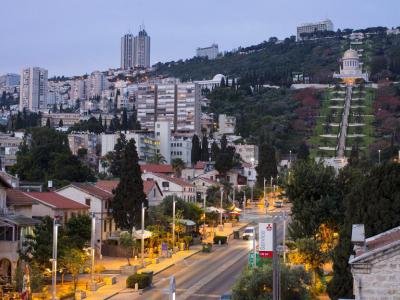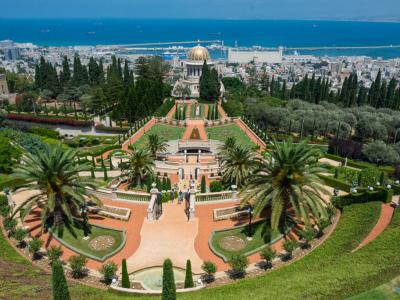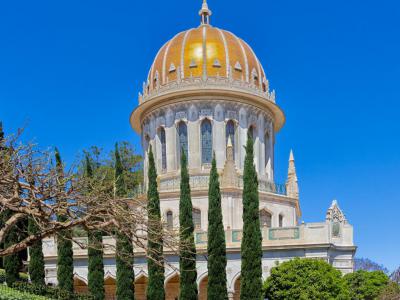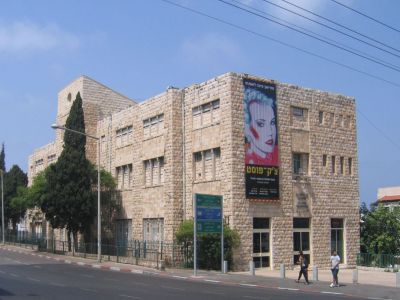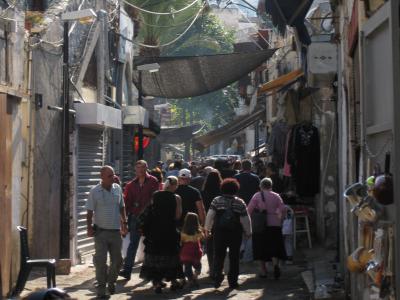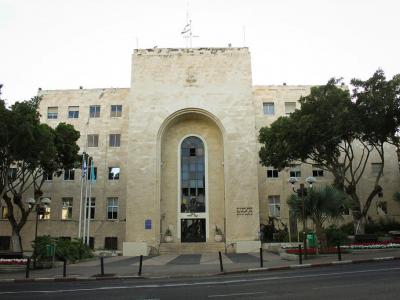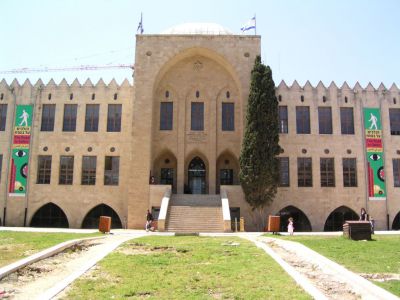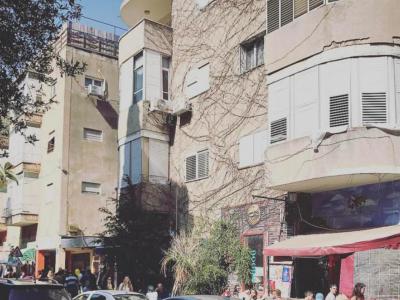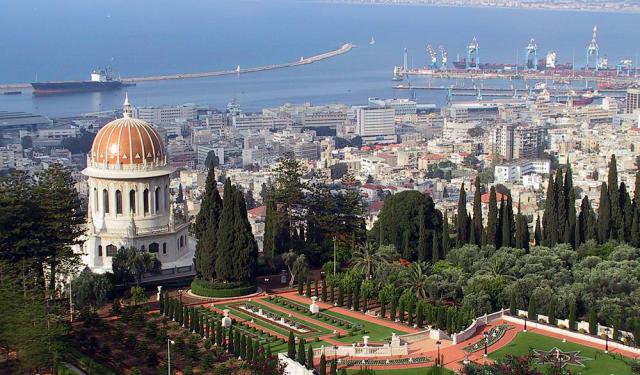
Haifa Introduction Walking Tour (Self Guided), Haifa
Built in tiers extending from the Mediterranean up the north slope of Mount Carmel, the city of Haifa is a busy seaport and a key gateway to Israel.
The area of present-day Haifa has been inhabited since Biblical times, spanning in history more than 3,000 years. Throughout the millennia, it has changed hands numerous times, being conquered and ruled by various kingdoms and empires including the Canaanites, Phoenicians, Assyrians, Babylonians, Persians, Hasmoneans, Romans, Byzantines, Arabs, Crusaders, Ottomans, and British.
The ultimate origin of the name Haifa remains unclear, although some believe it could be derived from the Hebrew word hof ("shore") or hof yafe, meaning "beautiful shore".
"Haifa works, Jerusalem prays, and Tel Aviv plays," they say. This proverb reflects the different personalities and roles of Israel's three largest cities, with an emphasis on Haifa's industrial and technological prowess. Being home to several prestigious academic institutions, such as the University of Haifa and the Technion – Israel Institute of Technology, Haifa also houses Madatech — the Israel National Museum of Science, Technology and Space.
Still, when it comes to religious and cultural life and entertainment, this beautiful coastal city deserves notice just as much. The most famous landmarks of Haifa include the immaculately landscaped terraces of the Baha'i Gardens, a UNESCO World Heritage Site. At its heart is the golden-domed Shrine of the Báb, one of the most important Baha'i pilgrimage sites in the world. At the foot of the gardens lies the German Colony, established in the 19th century, whose shops, galleries, and restaurants line the bustling Ben Gurion Avenue, named after one of the founding fathers of Israel.
Other historic neighborhoods of note include Wadi Nisnas, renowned for its narrow streets, colorful markets, and diverse population, and Massada Street, a little-known bohemian enclave in downtown Haifa.
With a multicultural population such as Haifa's, comprising Jewish, Arab, Christian, and Baha'i communities, it is only natural that the city is home to the annual "Holiday of Holidays" festival celebrating ethnic and religious diversity with the events related to Christmas, Hanukkah, and Eid al-Fitr, among others.
Overall, Haifa is a vibrant and fascinating city with tonnes of beautiful sites to explore. This self-guided walking tour will help you make your exploration more enjoyable.
The area of present-day Haifa has been inhabited since Biblical times, spanning in history more than 3,000 years. Throughout the millennia, it has changed hands numerous times, being conquered and ruled by various kingdoms and empires including the Canaanites, Phoenicians, Assyrians, Babylonians, Persians, Hasmoneans, Romans, Byzantines, Arabs, Crusaders, Ottomans, and British.
The ultimate origin of the name Haifa remains unclear, although some believe it could be derived from the Hebrew word hof ("shore") or hof yafe, meaning "beautiful shore".
"Haifa works, Jerusalem prays, and Tel Aviv plays," they say. This proverb reflects the different personalities and roles of Israel's three largest cities, with an emphasis on Haifa's industrial and technological prowess. Being home to several prestigious academic institutions, such as the University of Haifa and the Technion – Israel Institute of Technology, Haifa also houses Madatech — the Israel National Museum of Science, Technology and Space.
Still, when it comes to religious and cultural life and entertainment, this beautiful coastal city deserves notice just as much. The most famous landmarks of Haifa include the immaculately landscaped terraces of the Baha'i Gardens, a UNESCO World Heritage Site. At its heart is the golden-domed Shrine of the Báb, one of the most important Baha'i pilgrimage sites in the world. At the foot of the gardens lies the German Colony, established in the 19th century, whose shops, galleries, and restaurants line the bustling Ben Gurion Avenue, named after one of the founding fathers of Israel.
Other historic neighborhoods of note include Wadi Nisnas, renowned for its narrow streets, colorful markets, and diverse population, and Massada Street, a little-known bohemian enclave in downtown Haifa.
With a multicultural population such as Haifa's, comprising Jewish, Arab, Christian, and Baha'i communities, it is only natural that the city is home to the annual "Holiday of Holidays" festival celebrating ethnic and religious diversity with the events related to Christmas, Hanukkah, and Eid al-Fitr, among others.
Overall, Haifa is a vibrant and fascinating city with tonnes of beautiful sites to explore. This self-guided walking tour will help you make your exploration more enjoyable.
How it works: Download the app "GPSmyCity: Walks in 1K+ Cities" from Apple App Store or Google Play Store to your mobile phone or tablet. The app turns your mobile device into a personal tour guide and its built-in GPS navigation functions guide you from one tour stop to next. The app works offline, so no data plan is needed when traveling abroad.
Haifa Introduction Walking Tour Map
Guide Name: Haifa Introduction Walking Tour
Guide Location: Israel » Haifa (See other walking tours in Haifa)
Guide Type: Self-guided Walking Tour (Sightseeing)
# of Attractions: 8
Tour Duration: 2 Hour(s)
Travel Distance: 3.5 Km or 2.2 Miles
Author: Caroline
Sight(s) Featured in This Guide:
Guide Location: Israel » Haifa (See other walking tours in Haifa)
Guide Type: Self-guided Walking Tour (Sightseeing)
# of Attractions: 8
Tour Duration: 2 Hour(s)
Travel Distance: 3.5 Km or 2.2 Miles
Author: Caroline
Sight(s) Featured in This Guide:
- Ben Gurion Avenue
- Hanging Gardens (Terraces of the Bahá'í Faith)
- Shrine of the Báb
- Haifa Museum of Art
- Wadi Nisnas
- Haifa City Hall
- Madatech — Israel National Museum of Science, Technology and Space
- Massada Street
1) Ben Gurion Avenue (must see)
Ben Gurion Avenue, situated in the charming city of Haifa, is a vibrant thoroughfare that beautifully showcases the rich cultural, historical, and architectural tapestry of this diverse Mediterranean metropolis. Named after David Ben-Gurion, Israel's first prime minister and a key figure in the nation's history, the avenue stretches from the lower city, ascends the slopes of Mount Carmel, and offers a unique blend of attractions and experiences for visitors and locals alike.
As you stroll along Ben Gurion Avenue, you'll be captivated by the delightful array of architectural styles, from the Bauhaus-inspired buildings and picturesque Ottoman-era structures to more contemporary designs. The tree-lined promenade is adorned with charming cafes, eclectic boutiques, and local art galleries, inviting visitors to immerse themselves in the dynamic atmosphere that encapsulates the spirit of Haifa.
Ben Gurion Avenue also serves as an important cultural and social hub in Haifa. It is home to the historic German Colony, established in the 19th century by German Templers, and the iconic Bahá'í Gardens, a UNESCO World Heritage Site and a true jewel of the city. As you make your way along the avenue, the breathtaking views of Haifa's port, the azure waters of the Mediterranean Sea, and the lush greenery of Mount Carmel create a captivating backdrop that highlights the beauty of this unique city.
A visit to Ben Gurion Avenue is more than just a walk through the city streets—it is a journey through Haifa's rich history, a celebration of its diverse culture, and an invitation to discover the countless stories that make this Israeli city truly unforgettable. Whether you're a history enthusiast, a food lover, or simply an admirer of urban beauty, Ben Gurion Avenue is sure to leave a lasting impression on anyone who wanders its enchanting path.
As you stroll along Ben Gurion Avenue, you'll be captivated by the delightful array of architectural styles, from the Bauhaus-inspired buildings and picturesque Ottoman-era structures to more contemporary designs. The tree-lined promenade is adorned with charming cafes, eclectic boutiques, and local art galleries, inviting visitors to immerse themselves in the dynamic atmosphere that encapsulates the spirit of Haifa.
Ben Gurion Avenue also serves as an important cultural and social hub in Haifa. It is home to the historic German Colony, established in the 19th century by German Templers, and the iconic Bahá'í Gardens, a UNESCO World Heritage Site and a true jewel of the city. As you make your way along the avenue, the breathtaking views of Haifa's port, the azure waters of the Mediterranean Sea, and the lush greenery of Mount Carmel create a captivating backdrop that highlights the beauty of this unique city.
A visit to Ben Gurion Avenue is more than just a walk through the city streets—it is a journey through Haifa's rich history, a celebration of its diverse culture, and an invitation to discover the countless stories that make this Israeli city truly unforgettable. Whether you're a history enthusiast, a food lover, or simply an admirer of urban beauty, Ben Gurion Avenue is sure to leave a lasting impression on anyone who wanders its enchanting path.
2) Hanging Gardens (Terraces of the Bahá'í Faith) (must see)
Immersed in the vibrant landscape of Haifa, the Hanging Gardens of Haifa, also known as the Terraces of the Bahá'í Faith, are an awe-inspiring example of beauty, spirituality, and architectural ingenuity. Nestled on the slopes of Mount Carmel, these breathtaking gardens extend over 19 terraces, each adorned with exquisite flora, flowing water features, and meticulously manicured greenery that create a serene and harmonious atmosphere.
Constructed between 1987 and 2001 under the guidance of renowned architect Fariborz Sahba, the Hanging Gardens of Haifa serve as a symbolic representation of the Bahá'í faith, a monotheistic religion that promotes unity and the oneness of humanity. At the heart of these majestic terraces lies the golden-domed Shrine of the Báb, the resting place of the Báb, the founder of the Bábí Faith and the forerunner of Bahá'u'lláh, the founder of the Bahá'í Faith.
The Hanging Gardens are designed with a striking geometrical precision, as each terrace unfolds into the next, offering spectacular panoramic views of the city of Haifa, the Mediterranean Sea, and the surrounding region. The gardens are adorned with elements inspired by diverse cultures and religions, embodying the universal ideals of the Bahá'í Faith and fostering a sense of global unity and harmony.
As both a UNESCO World Heritage Site and an enduring symbol of spiritual devotion, the Hanging Gardens of Haifa captivate visitors from all corners of the world. A visit to this tranquil oasis not only provides a feast for the eyes, but also inspires contemplation and reflection on the unifying principles that underpin the Bahá'í Faith. Whether seeking a deeper spiritual connection or simply an escape from the bustling city life, the Hanging Gardens of Haifa are an unforgettable destination that leaves a lasting impression on all who encounter its enchanting beauty.
Constructed between 1987 and 2001 under the guidance of renowned architect Fariborz Sahba, the Hanging Gardens of Haifa serve as a symbolic representation of the Bahá'í faith, a monotheistic religion that promotes unity and the oneness of humanity. At the heart of these majestic terraces lies the golden-domed Shrine of the Báb, the resting place of the Báb, the founder of the Bábí Faith and the forerunner of Bahá'u'lláh, the founder of the Bahá'í Faith.
The Hanging Gardens are designed with a striking geometrical precision, as each terrace unfolds into the next, offering spectacular panoramic views of the city of Haifa, the Mediterranean Sea, and the surrounding region. The gardens are adorned with elements inspired by diverse cultures and religions, embodying the universal ideals of the Bahá'í Faith and fostering a sense of global unity and harmony.
As both a UNESCO World Heritage Site and an enduring symbol of spiritual devotion, the Hanging Gardens of Haifa captivate visitors from all corners of the world. A visit to this tranquil oasis not only provides a feast for the eyes, but also inspires contemplation and reflection on the unifying principles that underpin the Bahá'í Faith. Whether seeking a deeper spiritual connection or simply an escape from the bustling city life, the Hanging Gardens of Haifa are an unforgettable destination that leaves a lasting impression on all who encounter its enchanting beauty.
3) Shrine of the Báb
The history of the Shrine of the Báb in Haifa, begins with the life and teachings of the Báb, the founder of the Bábí Faith and the herald of Bahá'u'lláh, the founder of the Bahá'í Faith. The Báb, born Siyyid `Alí Muḥammad Shírází in 1819 in Shiraz, Iran, declared his mission in 1844 and quickly attracted a considerable following. His teachings, which emphasized spiritual and social renewal, were seen as a threat by the Iranian government and the religious establishment. Consequently, the Báb was imprisoned, and in 1850, he was executed by a firing squad.
Following the Báb's martyrdom, his remains were secretly preserved by his followers for several decades. In 1899, under the direction of `Abdu'l-Bahá, the eldest son of Bahá'u'lláh and the appointed leader of the Bahá'í Faith after Bahá'u'lláh's passing, the remains were finally brought to Haifa and placed in a temporary mausoleum on the slopes of Mount Carmel.
The construction of the Shrine of the Báb commenced in 1909 when Abdu'l-Bahá placed the sacred remains of the Báb in a specially built tomb within the shrine's foundation. The initial structure, which housed the tomb, was designed by Abdu'l-Bahá and completed in 1913.
The construction of the shrine continued under the guidance of Shoghi Effendi, `Abdu'l-Bahá's grandson, and the Guardian of the Bahá'í Faith. Shoghi Effendi enlisted the assistance of renowned Canadian architect William Sutherland Maxwell to design the superstructure, including the golden dome. The shrine was completed in 1953.
In 2008, the Shrine of the Báb, along with the surrounding Bahá'í Gardens, was designated a UNESCO World Heritage Site in recognition of its outstanding universal value and its significance to the Bahá'í Faith.
Tip:
You are not allowed to climb the steps back up, so keep in mind that at the end of your time here you can exit and a walk or taxi to your next destination.
Following the Báb's martyrdom, his remains were secretly preserved by his followers for several decades. In 1899, under the direction of `Abdu'l-Bahá, the eldest son of Bahá'u'lláh and the appointed leader of the Bahá'í Faith after Bahá'u'lláh's passing, the remains were finally brought to Haifa and placed in a temporary mausoleum on the slopes of Mount Carmel.
The construction of the Shrine of the Báb commenced in 1909 when Abdu'l-Bahá placed the sacred remains of the Báb in a specially built tomb within the shrine's foundation. The initial structure, which housed the tomb, was designed by Abdu'l-Bahá and completed in 1913.
The construction of the shrine continued under the guidance of Shoghi Effendi, `Abdu'l-Bahá's grandson, and the Guardian of the Bahá'í Faith. Shoghi Effendi enlisted the assistance of renowned Canadian architect William Sutherland Maxwell to design the superstructure, including the golden dome. The shrine was completed in 1953.
In 2008, the Shrine of the Báb, along with the surrounding Bahá'í Gardens, was designated a UNESCO World Heritage Site in recognition of its outstanding universal value and its significance to the Bahá'í Faith.
Tip:
You are not allowed to climb the steps back up, so keep in mind that at the end of your time here you can exit and a walk or taxi to your next destination.
4) Haifa Museum of Art
The Haifa Museum of Art is a prominent cultural institution that showcases an eclectic collection of contemporary and modern art, celebrating both local and international artists. Established in 1951, the museum is housed in a beautifully preserved, historical building that once served as the city's main marketplace.
With an ever-evolving collection of over 7,000 works, the Haifa Museum of Art offers a dynamic and enriching experience for art enthusiasts, tourists, and locals alike. The museum's exhibitions, ranging from paintings and sculptures to photography and installations, provide a platform for artistic exploration and dialogue. The works on display span various artistic movements, styles, and themes, ensuring a captivating experience for visitors of all interests and backgrounds.
In addition to its permanent collection, the Haifa Museum of Art hosts a variety of temporary exhibitions, featuring both emerging and established artists from Israel and around the world. These exhibitions, combined with engaging educational programs, workshops, and guided tours, foster a deeper appreciation and understanding of contemporary and modern art.
Why You Should Visit:
Smart use of exhibits on 2 floors, plus air-conditioning, toilets and plenty of space.
Of course there's a shop and a café as well!
With an ever-evolving collection of over 7,000 works, the Haifa Museum of Art offers a dynamic and enriching experience for art enthusiasts, tourists, and locals alike. The museum's exhibitions, ranging from paintings and sculptures to photography and installations, provide a platform for artistic exploration and dialogue. The works on display span various artistic movements, styles, and themes, ensuring a captivating experience for visitors of all interests and backgrounds.
In addition to its permanent collection, the Haifa Museum of Art hosts a variety of temporary exhibitions, featuring both emerging and established artists from Israel and around the world. These exhibitions, combined with engaging educational programs, workshops, and guided tours, foster a deeper appreciation and understanding of contemporary and modern art.
Why You Should Visit:
Smart use of exhibits on 2 floors, plus air-conditioning, toilets and plenty of space.
Of course there's a shop and a café as well!
5) Wadi Nisnas
Nestled in the heart of Haifa, Wadi Nisnas is a vibrant and culturally diverse neighborhood that offers visitors an authentic and enriching experience of the city's multi-ethnic charm. Originally an Arab village, Wadi Nisnas has evolved over time into a bustling urban enclave, renowned for its colorful marketplaces, unique street art, and rich culinary traditions. With a harmonious blend of Muslim, Christian, and Jewish communities living side by side, Wadi Nisnas serves as a testament to Haifa's spirit of coexistence and tolerance.
As you meander through the narrow alleyways and cobbled streets of Wadi Nisnas, you'll discover a treasure trove of traditional shops, aromatic bakeries, and fragrant spice stalls, offering a sensory feast that is sure to tantalize the taste buds. The neighborhood's open-air market, known as the Wadi, is a hub of activity where vendors sell fresh produce, local delicacies, and handmade crafts, providing visitors with a genuine taste of Haifa's vibrant culture.
Wadi Nisnas is also home to a thriving art scene, with numerous murals, sculptures, and installations adorning its streets and public spaces. Each year, the neighborhood hosts the Wadi Nisnas Festival of Culture and Arts, which brings together artists from various backgrounds to showcase their work, promote dialogue, and celebrate the rich tapestry of Haifa's cultural identity.
As you meander through the narrow alleyways and cobbled streets of Wadi Nisnas, you'll discover a treasure trove of traditional shops, aromatic bakeries, and fragrant spice stalls, offering a sensory feast that is sure to tantalize the taste buds. The neighborhood's open-air market, known as the Wadi, is a hub of activity where vendors sell fresh produce, local delicacies, and handmade crafts, providing visitors with a genuine taste of Haifa's vibrant culture.
Wadi Nisnas is also home to a thriving art scene, with numerous murals, sculptures, and installations adorning its streets and public spaces. Each year, the neighborhood hosts the Wadi Nisnas Festival of Culture and Arts, which brings together artists from various backgrounds to showcase their work, promote dialogue, and celebrate the rich tapestry of Haifa's cultural identity.
6) Haifa City Hall
The history of the Haifa City Hall dates back to the early years of the State of Israel, when the need for a centralized municipal building emerged as the city grew and developed rapidly. The present City Hall was designed in the mid-20th century by two distinguished Israeli architects, Yohanan Ratner and Amnon Alexandroni, both known for their innovative and modernist approach to architecture.
The location chosen for the City Hall was the bustling Hadar HaCarmel neighborhood, which was well-connected to other parts of the city and served as a central hub for the local population.
Completed in the 1950s, the City Hall was designed to reflect the aspirations of a young and thriving nation, with a focus on modernism, innovation, and progress. The building's striking geometric design and prominent glass facade were emblematic of this forward-thinking approach, offering a powerful visual representation of Haifa's dynamic urban character.
In addition to its functional significance, the City Hall has also become an iconic symbol of Haifa's architectural heritage and a testament to the city's spirit of collaboration and unity. Today, the building continues to play a crucial role in the city's ongoing development, serving as a hub of civic activity.
The location chosen for the City Hall was the bustling Hadar HaCarmel neighborhood, which was well-connected to other parts of the city and served as a central hub for the local population.
Completed in the 1950s, the City Hall was designed to reflect the aspirations of a young and thriving nation, with a focus on modernism, innovation, and progress. The building's striking geometric design and prominent glass facade were emblematic of this forward-thinking approach, offering a powerful visual representation of Haifa's dynamic urban character.
In addition to its functional significance, the City Hall has also become an iconic symbol of Haifa's architectural heritage and a testament to the city's spirit of collaboration and unity. Today, the building continues to play a crucial role in the city's ongoing development, serving as a hub of civic activity.
7) Madatech — Israel National Museum of Science, Technology and Space (must see)
Madatech, also known as the Israel National Museum of Science, Technology, and Space, is an interactive and engaging institution dedicated to inspiring a love of learning and curiosity for visitors of all ages. Established in 1983, Madatech is housed within the historical premises of the former Technion-Israel Institute of Technology.
Madatech invites visitors to embark on a journey of discovery, as they explore the numerous exhibitions, hands-on exhibits, and educational programs that showcase the wonders of science, technology, engineering, and mathematics. From the marvels of the cosmos to the intricacies of the human body, Madatech offers a wide array of topics and experiences that cater to diverse interests and ignite the imaginations of all who step through its doors.
Children and adults alike can delve into the fascinating world of scientific exploration through interactive displays, live demonstrations, and immersive simulations. The museum's state-of-the-art planetarium and 4D theater provide captivating experiences, transporting visitors across the universe and into the microscopic world of atoms and molecules.
With a focus on education, Madatech offers a range of workshops, lectures, and programs designed to inspire the next generation of scientists, engineers, and innovators. Its dedicated Youth Science Park provides an outdoor learning environment where children can investigate the principles of physics, aerodynamics, and renewable energy through play.
As a dynamic and inspiring hub for scientific inquiry and creativity, Madatech offers an unforgettable experience for all who visit.
Why You Should Visit:
Very accessible for kids and has lots of different interactive activities and exhibitions.
Most exhibits are good for adults as well, and the collections of old instruments & machines are terrific.
Tip:
Make sure you have a lot of free time, as you might want to dedicate a full day for it!
Best to enjoy the science garden out back in the summer when kids can run into the water-fountain.
Madatech invites visitors to embark on a journey of discovery, as they explore the numerous exhibitions, hands-on exhibits, and educational programs that showcase the wonders of science, technology, engineering, and mathematics. From the marvels of the cosmos to the intricacies of the human body, Madatech offers a wide array of topics and experiences that cater to diverse interests and ignite the imaginations of all who step through its doors.
Children and adults alike can delve into the fascinating world of scientific exploration through interactive displays, live demonstrations, and immersive simulations. The museum's state-of-the-art planetarium and 4D theater provide captivating experiences, transporting visitors across the universe and into the microscopic world of atoms and molecules.
With a focus on education, Madatech offers a range of workshops, lectures, and programs designed to inspire the next generation of scientists, engineers, and innovators. Its dedicated Youth Science Park provides an outdoor learning environment where children can investigate the principles of physics, aerodynamics, and renewable energy through play.
As a dynamic and inspiring hub for scientific inquiry and creativity, Madatech offers an unforgettable experience for all who visit.
Why You Should Visit:
Very accessible for kids and has lots of different interactive activities and exhibitions.
Most exhibits are good for adults as well, and the collections of old instruments & machines are terrific.
Tip:
Make sure you have a lot of free time, as you might want to dedicate a full day for it!
Best to enjoy the science garden out back in the summer when kids can run into the water-fountain.
8) Massada Street
Massada Street is one of the most popular and bustling streets in the beautiful city of Haifa. It is located in the Hadar neighborhood, which is known for its historical significance and cultural diversity. The street is named after the ancient fortress of Masada, which is located in the southern part of Israel and is an important historical site.
Massada Street is a lively and vibrant place, where locals and tourists alike come to shop, dine, and socialize. The street is lined with a variety of shops, cafes, and restaurants that cater to a wide range of tastes and budgets. Whether you are looking for designer clothes, handmade jewelry, or delicious Middle Eastern cuisine, you are sure to find something to suit your needs on Massada Street.
One of the most notable features of Massada Street is its eclectic mix of architectural styles. The street is home to a number of beautiful old buildings, including some that date back to the Ottoman period. These buildings are characterized by their ornate balconies and intricate stonework, and they add a touch of old-world charm to the bustling street.
Masada Street is also the home of Israel’s Broken Fingaz Crew – one of Israel’s best-known graffiti collectives abroad. Consisting of four Haifa natives, who go by their artistic aliases Tant, Deso, Kip, and Unga, the collective employs their daring graffiti to bring vitality to urban architecture worldwide, earning widespread acclaim. Undoubtedly, Masada Street is also a center of artistic ideas in Haifa.
Massada Street is a lively and vibrant place, where locals and tourists alike come to shop, dine, and socialize. The street is lined with a variety of shops, cafes, and restaurants that cater to a wide range of tastes and budgets. Whether you are looking for designer clothes, handmade jewelry, or delicious Middle Eastern cuisine, you are sure to find something to suit your needs on Massada Street.
One of the most notable features of Massada Street is its eclectic mix of architectural styles. The street is home to a number of beautiful old buildings, including some that date back to the Ottoman period. These buildings are characterized by their ornate balconies and intricate stonework, and they add a touch of old-world charm to the bustling street.
Masada Street is also the home of Israel’s Broken Fingaz Crew – one of Israel’s best-known graffiti collectives abroad. Consisting of four Haifa natives, who go by their artistic aliases Tant, Deso, Kip, and Unga, the collective employs their daring graffiti to bring vitality to urban architecture worldwide, earning widespread acclaim. Undoubtedly, Masada Street is also a center of artistic ideas in Haifa.
Walking Tours in Haifa, Israel
Create Your Own Walk in Haifa
Creating your own self-guided walk in Haifa is easy and fun. Choose the city attractions that you want to see and a walk route map will be created just for you. You can even set your hotel as the start point of the walk.
Bahai World Center Tour
The Bahai Faith is a monotheistic religion that stemmed from Shiʻa Islam in the 19th century. Since its emergence, the religion has spread its influence to many parts of the world, with its spiritual and administrative center established in Israel.
The Bahai World Centre in Haifa is a religious complex that comprises several buildings, the most notable of which is the Shrine of the Bab, a holy... view more
Tour Duration: 2 Hour(s)
Travel Distance: 2.5 Km or 1.6 Miles
The Bahai World Centre in Haifa is a religious complex that comprises several buildings, the most notable of which is the Shrine of the Bab, a holy... view more
Tour Duration: 2 Hour(s)
Travel Distance: 2.5 Km or 1.6 Miles
The Most Popular Cities
/ view all
